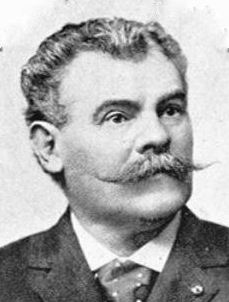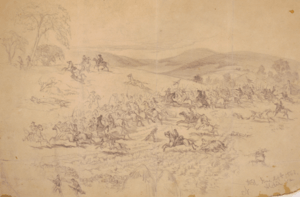Hampton S. Thomas facts for kids
Quick facts for kids
Hampton S. Thomas
|
|
|---|---|

Brevet Colonel Hampton S. Thomas, c. 1899
|
|
| Born | November 3, 1837 Quakertown, Pennsylvania, U.S. |
| Died | May 21, 1899 (aged 61) Philadelphia, Pennsylvania, U.S. |
| Allegiance | United States |
| Service/ |
United States Army (Union Army) |
| Rank | Major |
| Unit | 1st Pennsylvania Cavalry |
| Battles/wars | American Civil War:
|
| Awards | Medal of Honor |
Hampton Sidney Thomas (born November 3, 1837 – died May 21, 1899) was a brave soldier from the United States. He fought for the Union Army as a major in the 1st Pennsylvania Cavalry during the American Civil War. He earned the highest award for bravery, the Medal of Honor.
He received this award for his amazing courage on April 5, 1865. This happened during the Battle of Amelia Springs in Virginia. During this battle, he captured enemy cannons and flags. He also helped destroy a wagon train belonging to the Confederate States Army. He was given the Medal of Honor on January 15, 1894.
Contents
Early Life
Hampton Sidney Thomas was born in Quakertown, Pennsylvania, on November 3, 1837. His parents were David Thomas and Jesse (Baker) Thomas. He grew up near Philadelphia and went to public schools there. As a teenager, he chose to become a carpenter.
In 1860, Thomas started learning carpentry from a master carpenter named Franklin Ashley. He lived with Ashley and his family in Oxford, Pennsylvania.
Fighting in the Civil War
Joining the Fight
When the American Civil War began, Hampton S. Thomas lived in Chester County, Pennsylvania. He was one of the first people from Pennsylvania to join the army. This happened after President Abraham Lincoln asked for volunteers in April 1861. This call came after the Battle of Fort Sumter, when Confederate troops took over the fort.
Thomas joined the army on April 21, 1861, in West Chester, Pennsylvania. He was 23 years old. The next day, he officially became a corporal in Company E of the 9th Pennsylvania Infantry. After serving for three months, he was honorably discharged on July 29.
Just two days later, Thomas joined the army again. This time, he signed up for three years in Harrisburg, Pennsylvania. On August 1, he became a second lieutenant in Company G of the 1st Pennsylvania Cavalry. His unit was sent to the main battle area, called the Eastern theater. They joined the U.S. Army of the Potomac. On September 27, he was promoted to first lieutenant.
Key Battles and Bravery
On November 26, Thomas and his regiment had small fights near Dranesville, Virginia. Their first big fight was the Battle of Dranesville on December 20. They supported Union cannons during this battle. In the spring of 1862, they scouted and defended areas around Catlett's Station and the Orange and Alexandria Railroad.
In April 1862, Thomas became an assistant adjutant-general. This meant he helped manage the brigade (a large group of soldiers). On April 18, he and his men captured Falmouth, Virginia. Because of their success, Thomas was promoted to captain on May 5. He then led Company M. They were assigned to guard and scout areas, helping Union generals Irvin McDowell and George B. McClellan.
They helped stop Confederate General Stonewall Jackson near Strasburg. They also supported Pennsylvania's "Bucktails" in a fight near Harrisonburg on June 6. Their next major battles were the Battle of Cedar Mountain (August 8) and the First Battle of Rappahannock Station (August 20–25). They also fought in the Second Battle of Bull Run (August 28–30).
Later, they helped defend Washington, D.C. During the Battle of Fredericksburg (December 11–15), they faced heavy enemy fire. Many soldiers were lost, including their commander, General George Dashiell Bayard.
On April 1, 1863, Thomas became an inspector-general. He took part in Stoneman's 1863 raid. That summer, he led his cavalrymen to recapture Union cannons at Fleetwood Hill. This happened during the Battle of Brandy Station on June 9, where Union forces fought Confederate General J.E.B. Stuart.
On June 17, Thomas fought in the Battle of Aldie. His cavalry pushed Confederate soldiers back. They clashed again in the Battle of Upperville. They also attacked the rear of Stuart's army near Westminster on June 30. Then they headed towards Adams County, Pennsylvania.
During the third day of the Battle of Gettysburg on July 3, 1863, Thomas led a charge. His Union men attacked the left side of 12,500 Confederate cavalry and infantry. This fierce fight helped force the Confederates to retreat.
After more charges, the Confederate cavalry had to retreat. Thomas and his troops then chased the retreating Confederate Army into Maryland and Virginia. They fought again near Shepherdstown (July 15) and in the Battle of Culpeper Court House (September 13). Thomas was badly wounded during the Battle of Bristoe Station (October 14) and was in the hospital for three months.
His first big fight after recovering in 1864 was the Battle of Todd's Tavern (May 7, 1864). He led a cavalry charge to rescue his commander, Henry Eugene Davies, who had been captured. Thomas and his men then joined the Union's Overland Campaign. They fought in the Battle of Yellow Tavern (May 11), where Confederate general J.E.B. Stuart was fatally wounded. They also fought under Major-General Philip Sheridan during his raid on Richmond.
After rejoining the Army of the Potomac, they fought in many battles. These included Battle of Haw's Shop (May 28), Battle of Cold Harbor (May 31 – June 12), and Battle of Trevilian Station (June 11–12). They also fought in the Battle of Saint Mary's Church (June 24). During the Second Battle of Ream's Station (August 25), Thomas was severely injured again. His horse was shot and killed, causing him to fall.
While he was recovering at home, he was transferred to his regiment's M Company artillery battery. He also returned to leading the 1st Pennsylvania Cavalry on October 1. His regiment continued to fight the enemy for the rest of that year.
Winning the Medal of Honor
On January 4, 1865, Thomas was promoted to major of the regiment. In early March, he led his men on a mission to clear out highwaymen who had killed Union soldiers. After this, he took command of a new cavalry unit. He then led his men in the battles of Battle of Dinwiddie Court House (March 31) and Battle of Five Forks (April 1). They also fought in operations along the South Side Railroad as part of the Third Battle of Petersburg (April 2).
Thomas had already been given the honorary rank of lieutenant colonel for his excellent service. On April 5, 1865, he received another honorary rank, colonel. This was for his actions in combat that day during the Battle of Amelia Springs. These actions would also earn him the U.S. Medal of Honor.
During the Battle of Amelia Springs, Thomas showed incredible bravery. He captured enemy cannons and several enemy flags. He also helped destroy a wagon train belonging to the Confederate Army.
Later that afternoon, Thomas and his men rejoined the main Union command. When General Sheridan and other officers were suddenly attacked, Thomas and his men stopped the Confederate attack. They fought hand-to-hand with pistols and sabers to protect their own regimental flags. Thomas was badly wounded again when his horse was shot and killed. This time, a Union Army surgeon had to amputate part of his leg below the knee. His leg bone was shattered beyond repair by a carbine ball.
After recovering from his injuries, Thomas was transferred to another cavalry unit on June 17, 1865. He was honorably discharged from the army on August 7, 1865, in Louisville, Kentucky.
Life After the War
After leaving the army, Thomas returned home to the Philadelphia area. He started working as a coal dealer. Around 1866, he and his wife, Sallie, had a daughter named Mary. Later, they had two more children, Lillian (born 1868) and Philip (born 1869).
In the late 1860s and early 1870s, Thomas held several public service jobs. He worked for the Pennsylvania State Senate. He was also a register of wills in West Chester, Pennsylvania, and a superintendent at the Philadelphia Almshouse. He also collected taxes and became a magistrate (a type of judge) in Philadelphia. He was a member of the Masonic lodge and active in the Grand Army of the Republic, a group for Civil War veterans. He was also involved with the Republican Party.
In July 1888, he and Sallie had another son, Bayerd G., but he lived for only eight weeks. In 1889, Thomas wrote about his experiences during the war. These writings were published in a magazine and a book.
In 1895, Thomas lived in Philadelphia and continued to work as a magistrate. On May 9, 1899, while at a hearing, he had a severe dizzy spell. This was his third such attack. He was taken home and diagnosed with a terminal illness. He died at his home two weeks later, on May 21, 1899.
After a military funeral, he was buried at Philadelphia's Monument Cemetery. When that cemetery closed in the 1950s, his remains were moved. He was reburied at the Lawnview Memorial Park in Rockledge, Pennsylvania.
See also




